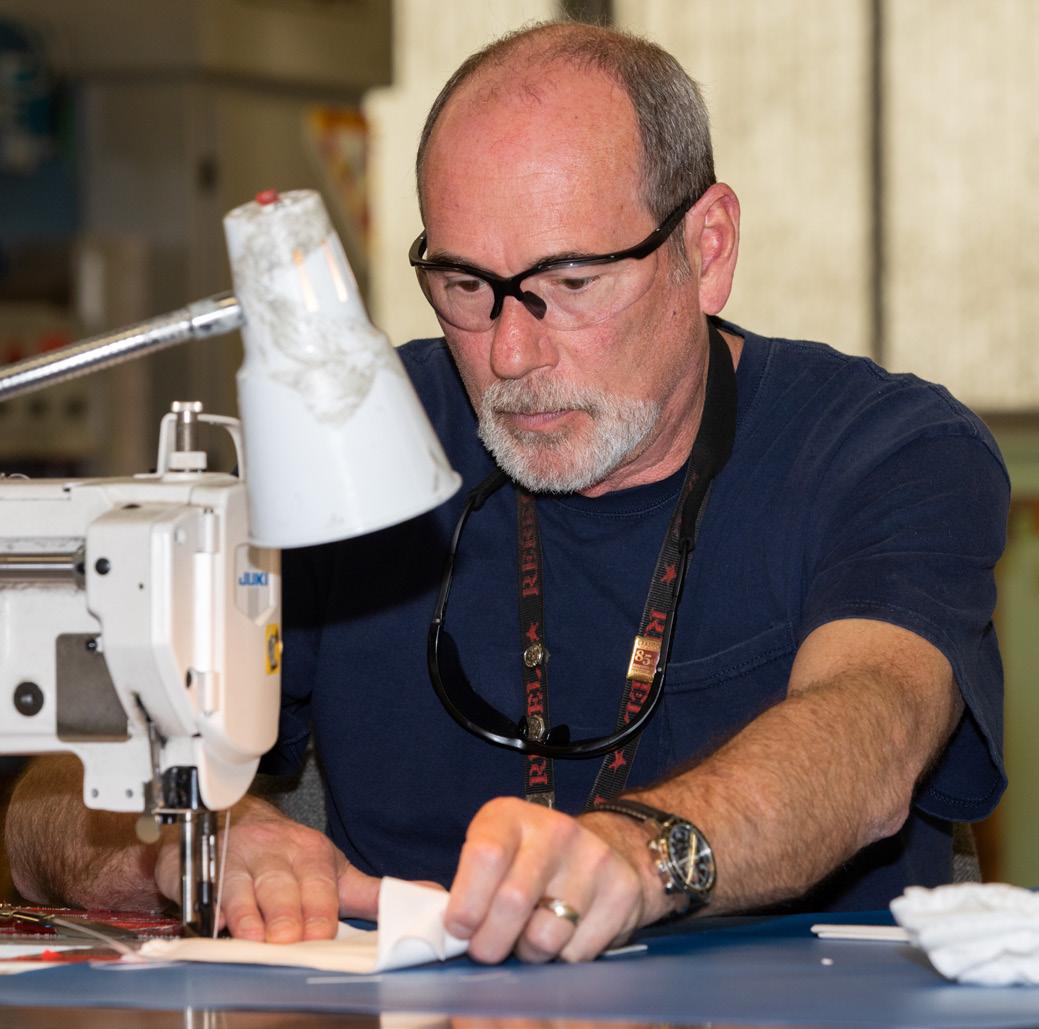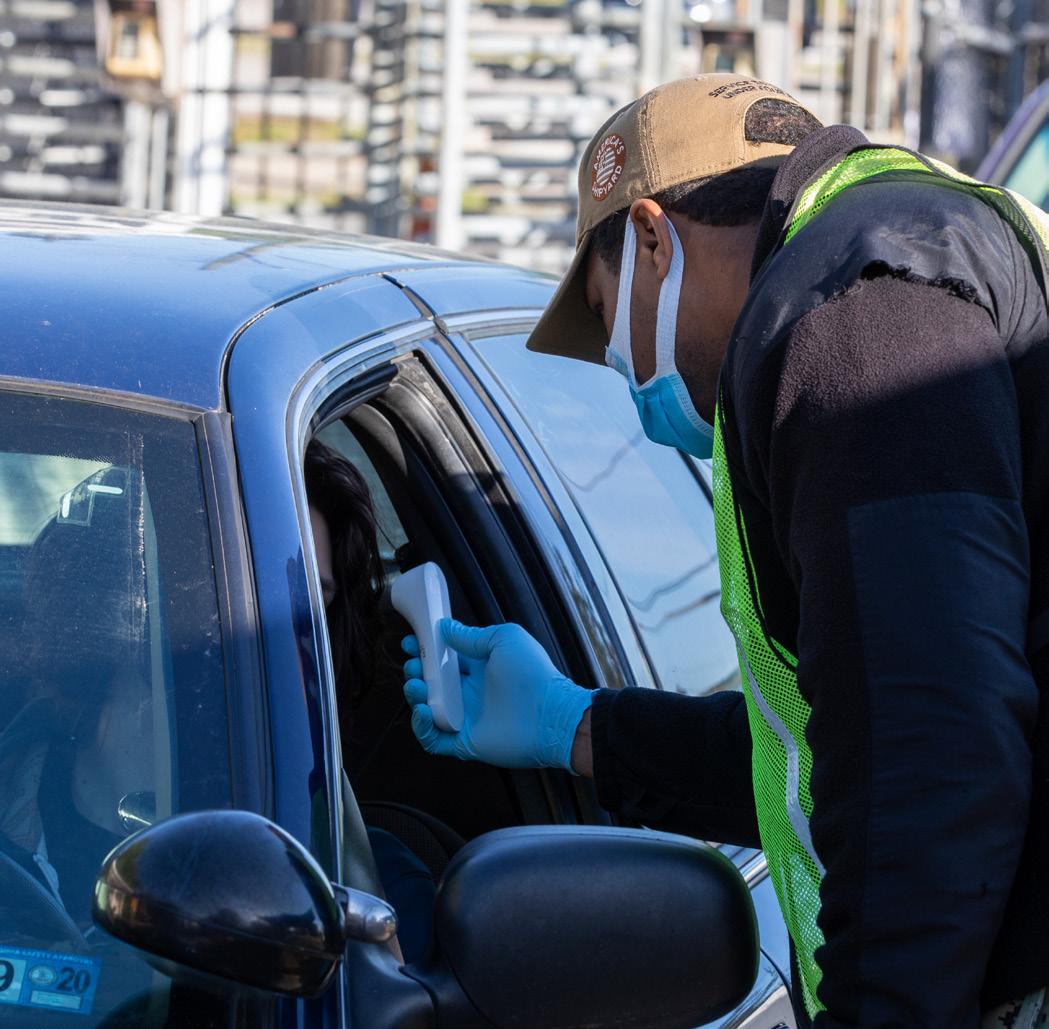
19 minute read
EYE ON INNOVATION


Advertisement

Norfolk Naval Shipyard Technology and Innovation (T&I) Lab Team Member James Klein displays 3-D printed headband from the T&I Lab's 3-D printer.
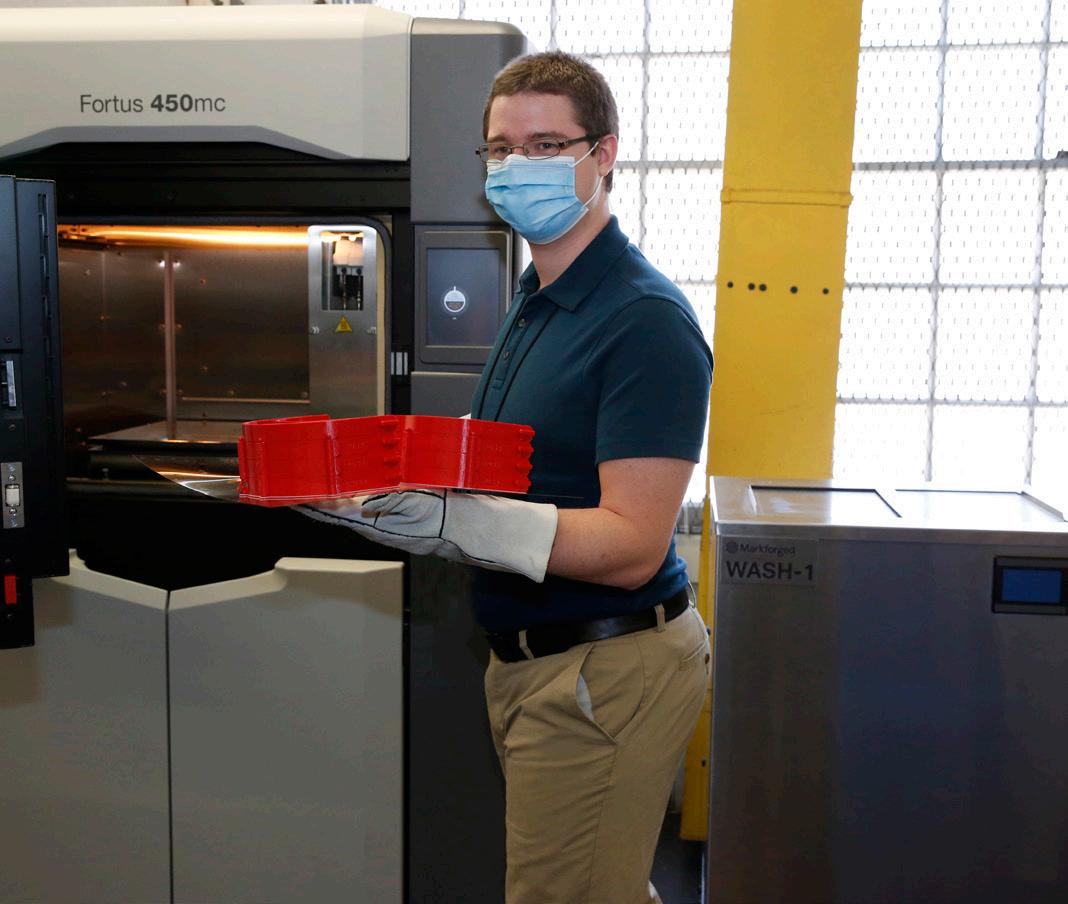
NNSY TAKES ON INNOVATIVE SOLUTIONS DURING COVID-19 PANDEMIC BY PRODUCING FACE SHIELDS
STORY BY KRISTI BRITT • PUBLIC AFFAIRS SPECIALIST
PHOTOS BY DANNY DEANGELIS AND TONY ANDERSON • NNSY PHOTOGRAPHERS
Innovative individuals across Norfolk Naval Shipyard (NNSY) have came together in the face of the COVID-19 pandemic to use additive manufacturing (AM) to produce face shields, meeting the challenge of the crisis head-on and providing equipment for their fellow shipyarders.
In Mid-March, NAVSEA reached out to Innovation Programs at the shipyards as well as other departments across NAVSEA to assess the corporation’s AM capability to produce personal protective equipment (PPE) so that workers could be properly fitted for the job while safely maneuvering through the current environment. Simultaneously, requests began pouring in from innovative individuals across NNSY with the strong desire to assist in PPE development and production efforts.
“It was a developing situation with COVID-19 and the growing concern for the need of PPE to continue daily service. We saw the need and began gauging each of the shipyard’s AM labs to scope their availability, capacity, and material inventory,” said NNSY Technology Insertion Manager Dale Berkley. “It became a group effort to answer the call and we began formalizing printing at the end of March.” Additive manufacturing labs across Norfolk Naval Shipyard have assisted in efforts to 3-D print face shields, including the lab in Code 361.

The face shields are composed of four parts: a headband to hold a clear-plastic shield, an elastic strap, and a reinforcement clip at the bottom to strengthen the plastic’s curve. The NNSY Technology & Innovation (T&I) Lab joined with AM labs across the shipyard, including the Nuclear Mechanical Group (Code 930N), Non-Nuclear Mechanical Group (Code 930), Non-Nuclear Inspection Division (Code 133), Carrier Programs (Code 361), Radiological Engineering Division (Code 105.2), and Nuclear Special Emphasis Division (Code 2320.6) to begin researching designs approved by the National Institutes of Health (NIH).
With alignment on a single approved design for the face shields, the labs took charge on their assignments and hit the ground running, printing the headbands and reinforcement clips using desktop, industrial, and resin three-dimensional (3-D) printers. The Nuclear Fluid Systems and Mechanical Engineering Division (Code 2320) and the NNSY T&I Lab handled printer material orders to ensure the teams had what they needed to get the job done as quickly as possible to meet their ramped up production schedule. Finally, once the clips and headbands were completed, they were turned over to the Production Resource Department (Code 900), Facilities Department (Code 980), Pipefitting Group (Code 960), and the SIOP Program Management Office (PMO) who developed the clear-plastic shields – finalizing assembling of the product and distributing them across the shipyard, as well as to local partners.
“As a team, we were able to take these designs and iron out the printing and assembly process, testing and perfecting it so that we were able to make these masks as quickly as possible,” said Code 930 Nuclear Continuious Training and Development (CTD) Coordinator Kyle Cooper. “It’s been a learning experience for everyone. We were able to cut down the printing of headbands themselves down to 57 minutes which initially was three and a half hours. It came down to trial and error, sharing our input and working towards making the best product possible.”
“This is a true testament to the teamwork here at NNSY, everyone coming together to provide their input and services with a common goal in mind,” said NNSY T&I Community of Practice (CoP) Lead and AM Subcommittee Lead Jessica Roberts. “It was a challenge we hadn’t really faced before to this degree as this was the first time all the AM labs across the shipyard had come together for a single project. So many departments needed to be aligned and understand each other’s abilities and what they would be bringing to the table. It was an evolving process and communication was
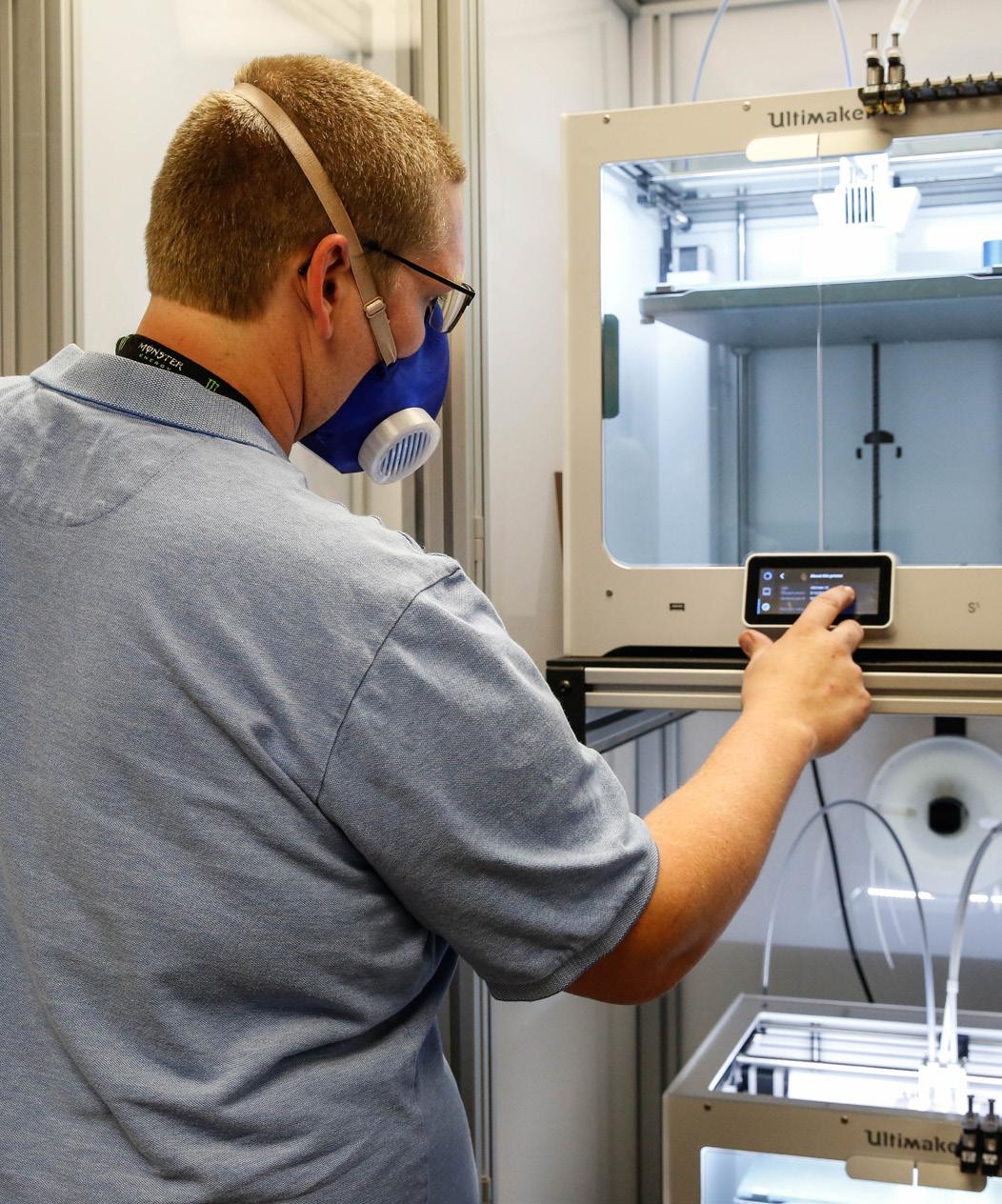
ABOVE: Code 930 Nuclear Continuious Training and Development (CTD) Coordinator Kyle Cooper sets up one of six printers in his department to 3-D print a prototype; BELOW: Additive Manufacturing labs across the shipyard have been working to print PPE to benefit the employees.
key to ensure everything went as smoothly as possible.”
Code 133 Non-Nuclear Inspection Division’s Adam and Joel Seamster used their large-capacity AM Lab, composed of over 20 desktop printers, to mass-produce headbands and clips. They helped ensure the technical aspect of the job was handled, working with the various labs to optimize the selected design for quicker and more cost effective printing, as well as testing materials for the best quality.
NNSY T&I Lab’s James Keim noted that this was a great experience to be able to work together with others within the shipyard for a common goal – to protect their fellow shipyarders. “While the waterfront was working to adapt to the new constraints created by COVID-19, the Innovation Program wanted to find ways to alleviate that burden and prevent it from getting worse. When it was evident that PPE was becoming scarce, it was clear that it was an immediate action we could take. We did not want to wait for the requests to come in because by then it would be too late. It made more sense to us to be ready with a stockpile for when the need hit. As for starting the process, we looked to what other groups had started. Since Virginia was not hit as hard, as fast as other states, we were able to make use of other’s experience to make ours smoother. The National Institutes of Health (NIH) had actually started a collection of PPE designs that they approved. We chose one as a starting point and adjusted our print parameters and materials until we came up with a print package that worked best for us.”
He added, “This truly was a team effort. There was a ton of eagerness across the board to get started and assist. We have many in the AM community with varied experience. When we were optimizing our prints, we made sure any improvements we found went out to all the other labs so they could try them. As material shortages hit us, we got together to prioritize where our resources went to make sure we had the highest production possible.”
“Code 361 has been pursuing efforts in AM for quite some time in order to quickly design and prototype tooling required to complete special emphasis work,” said Code 2360.6 Nuclear Engineer Daniel Miller. “When there was a call to action, we were there to assist. Code 361 has been working closely with Code 105.2 and Code 2320, allowing for a multi-organization response to support those on the frontlines of the COVID-19 response. We were able to break down everyone’s role and responsibility and learn from one-another.”
Miller added, “I think I can speak for the whole team when I say that we felt a little helpless at the start of this pandemic. It felt like there was nothing that we could do to stop what was happening in our country and around the world. Therefore, when the 3D Printing COP reached out for help, we all jumped at the opportunity to try to make a difference. We wanted to help ease the worries of our shipyard and of our community in any way we could.”
“This was a partnership that provided a resource stream of this vital equipment for our community,” said PMO Program Integrator Jason Markle. “We were able to maintain a flow of fabrication materials, inventory levels, and coordinating storage, distribution, and supply lines. Each code and each team member had a part to play to ensure the success of the mission.”
Keim added, “Ultimately together the printer teams were able to make almost 2,000 shields for our workforce which I see as a win. It helped bridge the gap until the sail loft was able to start producing cloth masks. Through the process, I learned a lot. Most of my previous efforts were limited prototypes that I would normally only have to print a few times. Mass-producing a part added an extra layer of complexity. Normally I would focus on the form, fit, and function of my prints. These shields required me to take a much harder look at ways to reduce time and material costs without taking away from the quality. This is optimization experience that I can take into all of my future prints.”
Markle shared that in addition to providing PPE to the shipyard at large, the team was able to deliver two batches of face shields to the Portsmouth Naval Hospital for testing and use. “This effort readied NNSY to be called upon to lend our aid for equipment supply to those who need it in the community at large,” he said.
Roberts said, “This joint effort directly services the mission of the fleet. It was very powerful and inspiring to this group jump into the effort so enthusiastically. Watching everyone come together, bring their own talents to the table, and grow with this task was incredible to me. I look forward to what this team will accomplish in the future.”
For more information regarding innovation, contact the NNSY T&I Lab at 757-396-7180 or email the REAL Ideas program at NNSY_REALIdeas@navy.mil.
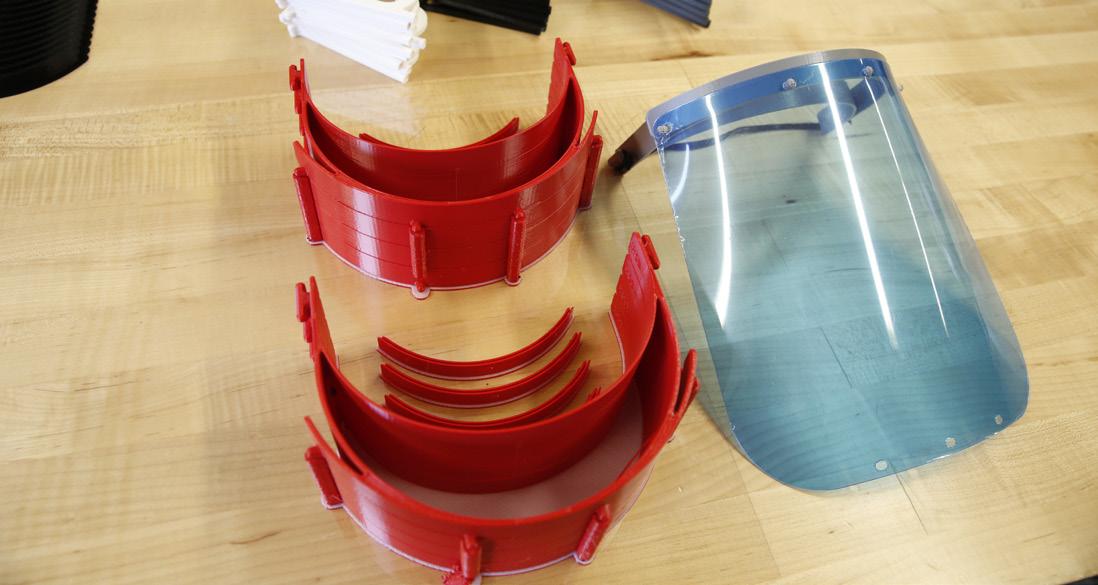
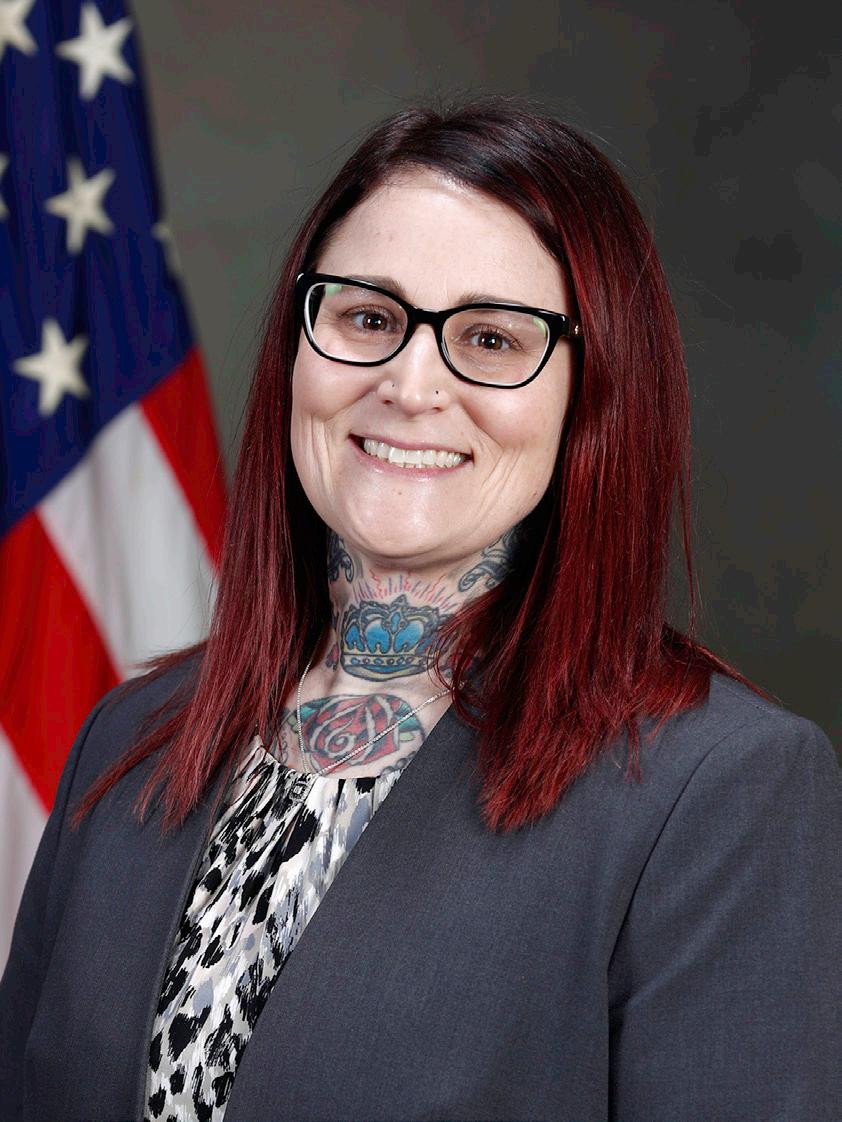
Ever since she was a little girl, Rachel Yarasavich has been an artist. Whether it was drawing, sculpting, or finding her passion in tattoos, Yarasavich admired artistic self-expression and sought a future where her art would be seen and appreciated. Little did she know that she would find a place to do just that at America’s Shipyard.
Yarasavich, a General Arrangements Branch (Code 254) Naval Architect, first stepped through the gates of Norfolk Naval Shipyard (NNSY) in 2003. With little knowledge of the shipyard or its mission, she joined the ranks of NNSY’s Sheetmetal Shop (Shop 17) as a sheet metal apprentice in the hopes of building her funds to move to Austin, Texas to become a tattoo artist.
“I had never envisioned myself becoming a sheet metal mechanic and had no idea what to expect when I started at NNSY,” said Yarasavich. “However, I found that working with sheet metal became like sculpting for me. It was easy for me to grasp because of my love for art and building. I really enjoyed what I was doing. It was a way to show my artistic expression while also becoming part of team that worked to service the Fleet. I found myself being really good at the tasks that I was given, tapping into skills I never knew I had. I continue to surprise myself every day with what skills I gain and what I’ve found I can accomplish.”
Following her graduation from the apprenticeship program, another pathway opened up that she decided to dive into – the Mechanic-to-Engineer Program. “I saw an opportunity to better myself and I decided to take a leap. Five of us from the entire shipyard were chosen for the program and we spent five years going through it. During that time, I worked as a technician in the Structural Engineering and Planning Division’s General Arrangements Branch (Code 254). I was
EDP HIGHLIGHT:
Rachel Yarasavich
STORY BY KRISTI BRITT • PUBLIC AFFAIRS SPECIALIST
finding my goals were expanding with each new skill I possessed. I was building a career for myself.”
Yarasavich is still in Code 254, with her career at NNSY now spanning 17 years and counting. She recently received an email regarding the Employee Development Program (EDP), opening further opportunities for her career. Intrigued with what was being offered, she reached out to her supervisor for an endorsement – both her supervisor and department head were supportive and ready to assist.
“I also reached out to my mentor – Structural Engineering & Planning Division (Code 250Q) Assessment Improvement Coordinator Gregory Coffie – to ask his thoughts on the program and if he thought I would be ready for the challenge,” said Yarasavich. “You see, I never thought of myself as someone in a leadership role before. However, he shared with me that many came to me for advice or help daily at the job. He said I was already exhibiting the role of someone who wanted to mentor and help others be the best they could be. Leaders need to be able to have those types of skills in order to be vulnerable with their people and have others be vulnerable with them as well. I then looked back on my career journey so far and found that I personally wanted to do more to expand my knowledge and skills to help my fellow shipyarders. So with Greg’s advice and the endorsement of my leaders – I applied for the EDP and I got in.”
Yarasavich was recently selected as one of NNSY’s four candidates in Cadre 9 of the EDP and is excited to step out of her comfort zone.
“Personal mastery is a big thing I want to accomplish during my time in the EDP,” she said. “I want to learn more about myself and learn how I can influence others to stay engaged and be empowered in their careers, just as others have done for me.”
The EDP is a six-month program designed to give qualified personnel the opportunity to experience firsthand the leadership competencies and styles, as well as the operational parameters and guidelines, that make up the total picture of successful naval shipyard operations. To learn more about the program, visit https://webcentral.nnsy.navy.mil/ departments/c900/C900CU/leadership%20developement/NNSY%20Executive%20 Developement%20Program.aspx.
Getting to Know Rachel Yarasavich
Q. Talk a little bit about your family and life outside of work.
A. My wife, Holly, and I are both workaholics – working hard to build our legacies and continuing to better ourselves each and every day. However, when we do get time outside of our jobs, we enjoy collecting and making art.
Together with my wife, we work together on a mutual hobby–assemblage art. Specifically robot–themed sculptures. We both conceptualize the designs and I am the main builder. This allows us to combine our love of art with my metalsmithing skills.
We also very much enjoy traveling. Though currently with COVID-19 putting any traveling on hold, we love exploring the outdoors and what awaits us beyond our home here in Virginia. We plan out our destinations, build a vacation binder, and away we go. Some recent destinations include Tokyo, Japan; British Columbia; Vancouver; Washington State; and California. Because we work a lot, we don’t get a lot of free time just to ourselves. But when we do, we want to spend that time doing something we enjoy. Whether it be art or traveling; we’re doing it together and loving every second of it.
Q. Talk a little bit about your grandfather.
A. My grandfather, Lt. Harvey H. Milhorn, was a devoted U.S. Naval Officer and a USS Arizona (include hull number) survivor on the attack at Pearl Harbor on December 7, 1941. Through his experiences, he taught me the importance of integrity, work ethic and human resilience to overcome overwhelming obstacles to be successful at life. His last naval career duty station before retirement was here at NNSY. He was a Code 346 Ship Superintendent from 1967 to 1970. My grandfather passed in 2002 and my family has been holding onto his cremains in hopes that someday we would be able to grant his final wishes – to join his fallen shipmates at the USS Arizona Memorial. An incentive of getting into the EDP program is a site tour at Pearl Harbor Naval Shipyard. Unfortunately, with the COVID-19 pandemic, all travel is on hold for our cadre and therefore so is the funeral. We are hoping that funeral plans will only be stunted until this fall.
Q. What is some advice you'd give to your fellow shipyarders?
A. A big thing I’ve picked up over the years is that no one is comfortable stepping out of their comfort zone; however, in order to grow and mature, you have to take that step. I once gave my wife a magnet that stated, “Life begins outside of your comfort zone,” and that’s something we’ve both been living by. We’ve experienced challenges at every turn but we face them and overcome them – becoming better versions of ourselves in the process.
Another thing I wanted to add is that everyone is capable of doing much more than they think – they just have to be willing to put in the time and research to make it happen. There are so many opportunities here at NNSY as well as outside our gates for folks in our industry to build a lifelong career.
Q. How has COVID-19 affected your time in the program?
A. As stated previously, all travel is currently on hold for us until the pandemic plays out. We were taken offline for the month of April to drive a shipyard-wide effort to field and distribute COVID-19 PPE requests to all departments and projects. This has given us the invaluable opportunity to network with a lot of people in a short amount of time while making a positive impact on the shipyard workforce. As a team, we were able to shift our focus to make this unpredictable experience work in our favor.
The COVID-19 pandemic has taught me some key organizational leadership concepts: • Leaders must be adaptive to the ever-changing environment within the organization • Networking is a vital skill to ensure the success of the organization • As a leader you must always demonstrate a united front with fellow leaders in the organization
Q. Are there any mentors you've had who have played a role in your career?
A. I wish I could speak on every single person who helped mentor me and lead me down the right path. But honestly, there are just too many people to name them all here. The reason I am where I am today is because people saw something in me, believed in me, and made suggestions or provided advice to me so that I could better myself. There have been many seasoned mechanics, supervisors, mentors, who helped me get to this place and I thank each and every one of them. You’ve been advocates for me, helped me find my place, and pushed me to go further than I ever thought possible. I’ve been so blessed to come in contact with people who care for me and believe in me and want to help me succeed. Thank you all.
The Executive Development Program, or EDP, is an annual program that opens its doors to candidates with a common goal: to learn from senior leadership from across the enterprise.
It's a competitive, corporate program across the four public shipyards. It's open to all NNSY civilians who are at a permanent GS-12 or GS-13 level who've been in their position for at least one year.
Each candidate is given the opportunity to directly mentor under some of the most influential senior leaders within America's Shipyard. In addition, they get to travel to the other public shipyards as well as Naval Sea Systems Command (NAVSEA) Headquarters.
For more information about the program, please contact Danielle Larrew at danielle.larrew@navy.mil.
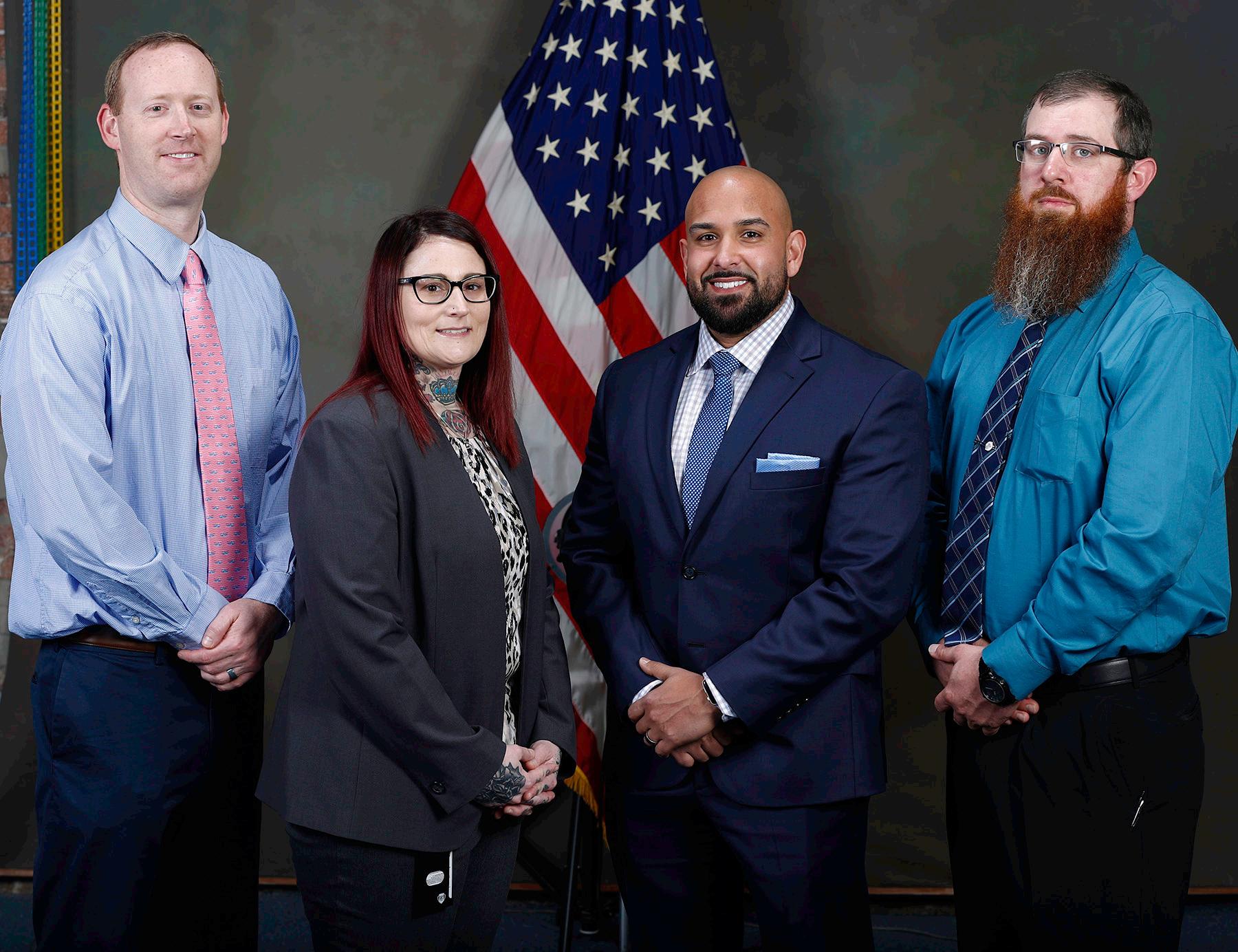
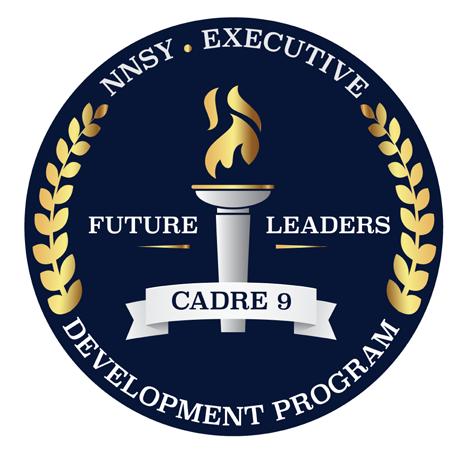
From Left to Right: Norfolk Naval Shipyard's (NNSY) Executive Development Program (EDP) Cadre 9 - Code 2370 Nuclear Engineering and Planning Department (NEPD) Training Branch Head Matt DeLong, Code 254 Naval Architect Rachel Yarasavich, Code 105.2 Radiological Engineer Sasha Norfleet, and Code 361 Nuclear Zone Manager Robert Jarman.
Behind the scene: A Message from the norfolk naval shipyard cultural change team
As a country, we have been adjusting to the impact of COVID-19, in search of our new normal. At Norfolk Naval shipyard, leadership has been challenged to not only figure out how to protect our fellow employees, but also figure out how to continue providing Service to the Fleet and completing work on the national assets that protect our way of life. There have been long days and nights put in to address physical distancing while performing work, how to protect the workforce, and prevent the spread of COVID-19 to other employees if someone tested positive. Some of the actions have been to send those who have come in contact with the individual who tested positive home with pay and to thoroughly clean the travel path of the affected employee. Leadership continued to follow up with each employee to ensure they were safe and if sick recovering from the illness.
This began as a seven day a week and at least three discussions a day to figure out which direction we were going in as a shipyard and how to align with the Navy and the government’s plan of action to prevent the spread of the virus. Leadership had to figure out how to continue working at the Kesselring Site in New York, NRMD Norfolk, NFPC, NRMD Kings Bay, NPTU Charleston, and how to execute critical path work evolutions at shipyard.

The dedication and commitment of leadership deserves to be appreciated as well as the many employees who accepted the challenge to continue working throughout this pandemic. While it is expected of leadership to go above and beyond, they still deserve to be appreciated for the excessive amount of time and effort put forth to ensure every employee is taken care of because they are our most valuable asset and at the heart of what we do to accomplish our mission to service the Navy.
Leadership has been very appreciative of the many employees who have stepped up in such a time as this to help the shipyard execute work on the national assets that protect our way of life.
To our military and civilian leaders, thank you for meeting the demand and exceeding expectations for protecting our workforce and their families. As a shipyard, our responsibility does not go away and we must continue to work as a team to protect each other, our families and our country.
R/
The Cultural Change Team
